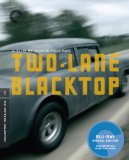| Reviews & Columns |
|
Reviews DVD TV on DVD Blu-ray 4K UHD International DVDs In Theaters Reviews by Studio Video Games Features Collector Series DVDs Easter Egg Database Interviews DVD Talk Radio Feature Articles Columns Anime Talk DVD Savant Horror DVDs The M.O.D. Squad Art House HD Talk Silent DVD
|
DVD Talk Forum |
|
|
| Resources |
|
DVD Price Search Customer Service #'s RCE Info Links |
|
Columns
|
|
|
Two-Lane Blacktop: The Criterion Collection
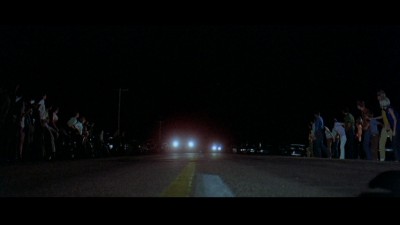
Please Note: The screen shots used here are from the 2007 DVD edition, not the Blu-ray under review.
Monte Hellman's dazed, stoically gorgeous 1971 film Two-Lane Blacktop is another one of those nuggets from the storied American cinema of the '70s that easily proves what's by now a commonplace among movie buffs -- that it was a time when the frantic desperation of the crumbling Hollywood studios made for a marked uptick in the adventurousness and quality of their product. Like the prior year's Five Easy Pieces, it's a road movie whose seeming uneventfulness and (in its case, pretty strictly exclusive) focus on low-key moments both mesmerizes as the film unfolds and leaves room for many surprising, refreshing layers of meaning and emotional response. But it's less talky, less intimate than Pieces; its closest kin from that bold, promising stretch in film history are Robert Altman's loose, revisionist, quietly mind-blowing takes on movie mythology. What Altman's McCabe and Mrs. Miller did for the Western, and what The Long Goodbye did for the noir/detective film, Two-Lane Blacktop does for the troubled-youth film exemplified by Rebel Without a Cause, with its adolescent skeptics, their emotional guardedness, and their cars that offer tantalizing, dangerous freedom. But Hellman's film is an even more radical leap, a more thoroughgoing crystallization and maximization, grabbing onto the vibe of the Rebellious movie moment where drag race epitomized a need to break away from ordered, productive life -- a fleeting, intoxicating glimpse of true freedom in all its lawless glory and tragedy -- and then taking its quest for freedom all the way to its very limit.
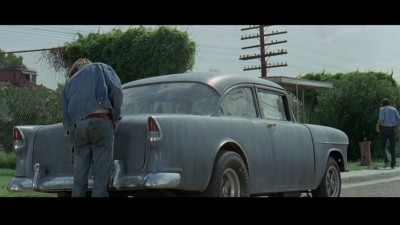
But it turns out that keeping one's eyes trained squarely on that glimpse of tantalizing existential right-nowness, never averting them toward the distractions of ambition, success, or assigned responsibilities, results not in some kind of ever-increasing thrill, but in an acclimatization to the freedom, a mood of torpor and inconsequentiality that's both blissful and unnerving (that simultaneous bliss and horror of resignation to only knowing this very moment, right now, nothing else -- no past, no future -- seems to me the essence of what's called existentialism). That's the permanent mood in which Two-Lane Blacktop's characters -- two young men we know only as "The Driver" (James Taylor) and "The Mechanic" (Dennis Wilson), along with a sweet-tart of a stoner/flower-child (Laurie Bird) they pick up -- move. The boys, apparently rootless and homeless (details of family and origin have been left far behind and are now wholly irrelevant), drag-race for money and are deeply and exclusively dedicated to their partnership in their racecar (a '55 Chevy modified extensively into something homemade, artisanal, of their own design). The girl, herself an experienced drifter (a runaway? We don't know; again, only what, where, and who she is right now can have any relevance) interested only in seeing where the day takes her, presumes a free-love ethic on her journey with these guys as the par for the course, and we know from their not-unfriendly but never romantic, mostly taciturn exchanges that there will be no "falling in love" (when there is, possibly, it's depicted as a dangerous distraction for The Driver, a useless flirtation with conventional romantic disappointment, and nothing more).
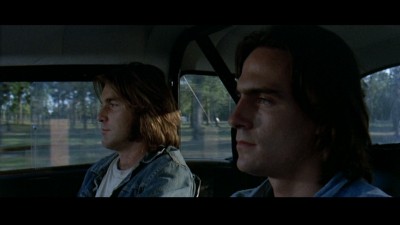
Meanwhile, a middle-aged figure late to the drop-out party (Warren Oates,The Wild Bunch) -- who's referred to in the credits only as G.T.O., a reference to the make of the zippy, expensive car he obviously acquired in a showroom somewhere -- feels his own phony, hip veneer of nonchalance threatened by the younger folks' genuine, listless unfamiliarity with any cares or worries; his "dropping out" has been impotently store-bought, as opposed to the kids' truly individual, independently homegrown methods. G.T.O.'s blustering projection of the kind of freedom he wishes he had, the kind these kids have without noticing or trying, is belied by his constant picking up of hitchhikers (among whom is future Paris, Texas star Harry Dean Stanton) in order to try to impress them with multiple (though all patently false) variations on a self-glamorizing, obviously made-up life story (he's a test driver who's been a test pilot, he saw battle in Korea, he's got the fanciest car stereo, he's "with it," you see?). With one midlife crisis-jaundiced eye on the underaged girl, G.T.O. challenges The Driver and The Mechanic to a winner-take-all cross-country race (to end, suggestively enough, in Washington D.C.); the victor gets the pink slip to the other party's vehicle, effectively ending their life on the permanently in motion, highway-bound terms of the film. The Driver, The Mechanic, and The Girl are completely immersed in and living, moment by moment, the freedom that James Dean and Natalie Wood could, in the Eisenhower era, but dimly and longingly imagine. But with the artificial gravity of society and its hang-ups removed, they don't soar, they float; in Two-Lane Blacktop, that Rebel Without a Cause existential drag-race moment is elongated both temporally and geographically, all the way out to infinity; there's no end and no beginning, just this moment, and you drive and pick up enough bread to survive for the moment and keep on driving, never compromising yourself by thinking of anything beyond that, because when it's time for your drive to end, it will, no matter what your futile long-term plans might have been. Thus, the Big Race is anticlimactic, dissipating almost imperceptibly into nothingness as what's really at stake -- the sheer value and importance of not winning a "race but simply remaining in motion for the sheer necessity of it, no matter the cost, which may be steep -- becomes ever more clear. Life, as pragmatically yet profoundly envisioned by Hellman and Two-Lane Blacktop's philosophically astute screenwriter, Rudy Wurlitzer, is a highway, and just like it is in life -- as evocative, dream-like moments of the statistically inevitable "accidents," the death and carnage, out on the highways stoically remind us -- mortality is one of the highway's most concretely non-negotiable terms. Thus, the cross-country race "plot" is not milked for suspense (there's very little of that in the film, which is much less a story told than a philosophical, perhaps national, mood revealed laconically, through action), but as the permanently antsy characters' pretext to get on and stay on the road; their respectful but unblinking responses to their direct or indirect encounters with death on the journey, and the calm with which they accept the privations and demands of being always and forever driving from nowhere and to nowhere in particular, are all part and parcel of their knowledge that there's no "there" to get to, that remaining in motion until stopped is not even the most "important" thing in a world where "importance" is meaningless, but simply the only possible thing.
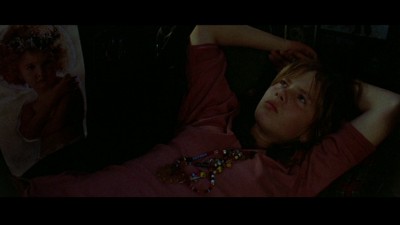
Two-Lane Blacktop's world fits its ethos; it's a place made for moving through, taking place in a nondescript but absolutely, recognizably American environment of endless drag strips, gas stations, and big, empty spaces (peculiarly, lonesomely compelling for their emptiness) cut through by a slim ribbon of two-lane highway. The film isn't self-consciously abstract (it's not as if Driver, Mechanic, or Girl refer to themselves or each other by their clearly archetype-reflecting monikers), but it holds a powerfully mythical allure; every naturalistically-shot frame seems to capture the rundown-utilitarian, raggedly beautiful essence of the country, the American Spirit circa 1970. The casting and performances, too, carry more than a whiff of the archetypal: Bird is a lost cherub, innocent (i.e., reckless) in a truer way than virginity or drug-freedom would entail, while Taylor and Wilson's effortlessly handsome visages, easy and affectless ways, and taciturn refusal to speak unless it has to do with the car imply they've never experienced a moment of worry or anxiety in their lives, and never intend to. Wilson (in real life, Sunshine State in his very blood) and Taylor (recently transplanted and a practitioner of the laid-back, introspective L.A. sound) are long-haired California boys (not hippies, nothing entailing that level of investment or risk of hypocrisy) who came from the land of rootless, restless freedom, the farthest edge of the frontier; with everything already covered, all territory explored, they have nothing to accomplish, no ambitions to weigh them down, and so the film's trajectory is a ricochet from West to East, with the technically and aesthetically ravishing final seconds of the film suggesting that The Driver and his Mechanic will ping-pong back and forth indefinitely, never with the anticipation of arriving here or there, but always for the sole purpose of staying in motion. It's as if what we've seen is just one cycle in a loop they'll repeat until, like the film reel we see melting and dissolving away before the credits roll, it stops itself, its arbitrary final end fully anticipated and accepted in advance by the protagonists' never-articulated but fully lived understanding that a refusal of "hope" and "future," and a consequent embrace of life, are what real freedom and fearlessness mean.
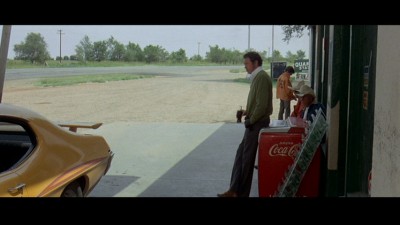
Hellman (who did his own editing, which surely has something to do with the perfect realization, through montage, of the film's pointedly slack pace), aided by the naturally-lit -appearing, sometimes near-documentary-feeling lighting and shooting style of cinematographers Jack Deerson and Gregory Sandor, accomplishes something that would sound impossible if you weren't seeing it with your own eyes: At 24 celluloid frames per second, he calibrates and conveys the exact, unanchored, lost-but-free movement of drifting. This is attained through the film's perfect confluence of languorous pacing, the physical presences and nearly averbal performances of the actors, and absolutely authentic highway views (unromanticized and unadorned, but drearily beautiful nonetheless) against which The Driver, The Mechanic, The Girl, and G.T.O. move and interact. There are so many ways in which a film can be "poetic," but Two-Lane Blacktop is poetic to the bone; it doesn't so much tell a story as capture and reveal, to the most acute extent, a feeling. Its characters don't develop so much as they gradually become more present and familiar to us. What there is of its story and plot is too static to even really call it episodic. Even the drift is something that comes not at all from forward-moving plot, but from the aimless movement our protagonists have given themselves over to as cinematically manifested by Hellman.
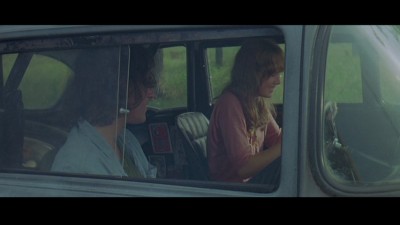
But the film has something rarer, and purer, to offer than a story that can be divided into acts or characters whose experiences change them. It's been expertly structured so as to feel "structureless"; despite being just a snatch of existences that were probably more or less the same before we took up with them and will continue more or less the same after we leave them, it's an experience that seems immersive, full, and whole because it has no contours that seem meant to shape it and pin it down into anything dramatic. The characters would surely scoff at any highfalutin philosophical talk (it's crucial to the film that any contemplative talking is not at all their bag), but Two-Lane Blacktop, in action (where it really counts) if not in words, engages us at a level beyond the rational, partaking of a transcendent power that the movies, as Hellman envisions them, seem particularly well-equipped to imbibe. It's a cinematic moment of Zen that, though it has an opening scene and a concluding one, mysteriously seems to have no ending and no beginning; it could variously be experienced, depending upon viewing circumstances, as all happening in a flash or as something luxuriantly, interminably drawn out. Taken moment by moment, the film has a gritty, lived-in feel, like a pair of jeans honestly faded over years and years, but it's through such a brilliant, sustained grasp of the texture of its plain, seemingly random moments -- all played out in unforced, real-feeling time -- that it accretes its powerful pull, its unemphatic but ineffable significance. It has nothing in it that appears showy or seeks undue attention, and it bears not the barest trace of pretention, but this is a movie that, in a way at once discombobulating and astringently soothing, touches eternity.
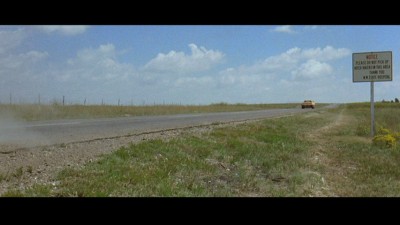
THE BLU-RAY DISC:
This AVC-MPEG4, 1080/24p high-definition transfer of Two-Lane Blacktop, preserving its original widescreen theatrical aspect ratio of 2.35:1, looks fantastic. A certain grain and celluloid texture is vital to the visually low-key, subtly sublime look that one associates with the period and is achieved so well here by cinematographers Jack Deerson and Gregory Sandor, and all of that is almost entirely present and accounted for (with perhaps a small handful of scenes wherein one could question a potential overuse of digital noise reduction rendering the image a bit too over-smoothed; this would be a judgment call best left to those with more expert eyes than mine, but I would say it's definitely not a horrible distraction in any case.) Otherwise, there's not a trace of edge enhancement, aliasing, or other compression artifacts; it's an impressively faithful, beautiful-looking transfer.
Sound:The sound is rich, full, and clear in either the original monaural soundtrack (presented as uncompressed PCM audio) or a new DTS-HD Master Audio 5.1 soundtrack based on the 5.1 surround updated created with Hellman's participation for Criterion's 2007 DVD release: The dialogue recording has the naturalistic quality of the era that puts it lower in the mix, but it sounds just right, and the engines sound remarkably, solidly deep revving down those highways. The 5.1 option is fine, but my purist's ears didn't detect much of a marked difference between that sound and the original mono that more closely replicates the true theatrical experience of the film, so the PCM track would be my preference and recommendation.
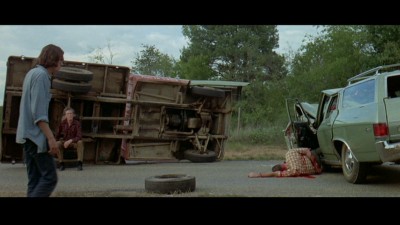
Criterion has ported over every extra from their 2007 two-disc edition of Two-Lane Blacktop, with the rather noticeable exception of a paperback reprint of Rudy Wurlitzer's screenplay that fit snugly into the DVD's well-designed box-sleeve, which is not included with the more standardly/minimally packaged Blu-ray. Otherwise, we have:
--Two feature-length audio commentaries: One with Hellman and filmmaker Allison Anders (
--"On the Road Again," a 42-minute documentary in which Hellman, some of his students from a film class he teaches at Cal Arts, and his daughter go on a road trip to revisit the locations and other important sites from the film's production. Hellman is a relaxed and very detailed storyteller with a sharp memory, and the best facilitator imaginable for this guided tour/reminiscence.
--"Make it Three Yards," a 38-minute reunion of Hellman and star James Taylor for a candid recollection of their most unusual, literally singular (it was Taylor's only film) six-week collaboration, regarded and remembered by Taylor, who has never seen the film, as its own on-the-road, spontaneous, unpredictable experience.
--"Somewhere Near Salinas," a half-hour conversation between Hellman and Kris Kristofferson, whose "Me and Bobby McGee" plays a brief but talismanic role in the film. The two make the singer/actor's peripheral involvement into a launching pad for a far-ranging discussion of shifting cultural values in music, literature, and film, and of Kristofferson's own long-running involvement in the movies as an actor.
--"Sure Did Talk to You," a 24-minute piece, covering multiple aspects of the film's preparation and production, that edits together an interview with producer Michael Laughton and a separate roundtable with production manager Walter Coblenz and Hellman's son Jared (who appeared briefly in the film) as interviewed by filmmaker Dennis Bartok and Variety's Steven Gaydos.
--"Those Satisfactions are Permanent," comprised of diverse, candid, and intimate audition/screen-test footage, discovered by Hellman in his garage during the preparation for the 2007 Two-Lane Blacktop DVD release, of Laurie Bird (15 min.) and James Taylor (10 min.), including a snatch of off-the-cuff musical performance by the latter.
--Two stills galleries: "Color Me Gone," approximately 60 behind-the-scenes production photos, and "Performance and Image," documenting the ongoing journey and fate of one of the film's '55 Chevys.
--An insert booklet with an insightful essay by critic Kent Jones, a reprint of a 1970 Rolling Stone article on the film's shoot by Michael Goodwin, and director Richard Linklater's "Ten (Sixteen, Actually) Reasons I LoveTwo-Lane Blacktop."
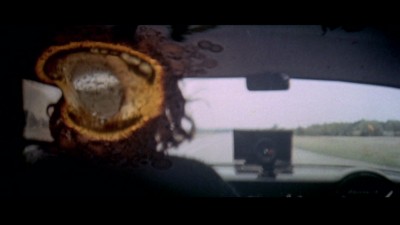
A subtle, sublime road-trip movie that drives right into the heart of America cultural (especially movie) mythology, Monte Hellman's Two-Lane Blacktop partakes of the same period-reflective yet timelessly transfixing lax anomie with which its contemporaneous New-Hollywood de-dramatized dramas -- it has a spirit especially kindred to Bob Rafaelson's and Altman's great films of the period -- is suffused. But (geographically speaking, at the very least, and probably aesthetically and narratively, too) it goes quite a bit further. The European influences that Hellman shared with most New Hollywood directors (particularly that of Antonioni), are noticeable, and the film's unhurried, amorphous pacing, along with its sense of space and an overall undiminished clarity of vision, will always be shocking and refreshing to see in a picture one knows was made and distributed by a big-profit-minded Hollywood studio. But beyond the inspiration they must have found in the bold freedoms pioneered by filmmakers from across the pond, Hellman and screenwriter Rudy Wurlitzer, along with their perfectly cast, taciturn and laconically handsome pop-star leads, James Taylor and Dennis Wilson, bring a texture and tone to the film that can only be American, at a moment when America was simultaneously looking sweetly at its own exhilarating mythology and sadly, resignedly at a burned-out, stagnating, no-frontier-left national mood. The open road is a rundown, melancholy place here, an atmosphere beautifully captured in the film's languid, naturalistic cinematography; the speed and unspoken, unshakeable dedication with which our nameless protagonists -- "The Driver," "The Mechanic," "The Girl" even the pitifully self-deluded square "G.T.O." -- traverse that seemingly endless territory give the film a majesty that's inimitable and irreplaceable. It seems unbelievable that a "slow," near-plotless film about going nowhere fast could be so uplifting and, with its lack of drama and expressed emotion, elicit such an intense emotional response, but that is Two-Lane Blacktop's languid, lingering effect. The feel of space, movement, and the affectless, weightless, frightening feel of real freedom is something Hellman miraculously imprints into every frame; he films the texture of moments, the look and feel of time passing as the unmoored, carefree, resigned rather than happy kids just let themselves drift, living the moment for the moment's sake and racing to be racing, not to win. It's nothing less than the purest, least romanticized cinematic poetry of letting go of attachment to anything and going out on the road, and as such one of the best American, most American films ever made. Highly Recommended.
|
| Popular Reviews |
| Sponsored Links |
|
|
| Sponsored Links |
|
|
| Release List | Reviews | Shop | Newsletter | Forum | DVD Giveaways | Blu-Ray | Advertise |
|
Copyright 2024 DVDTalk.com All Rights Reserved. Legal Info, Privacy Policy, Terms of Use,
Manage Preferences,
Your Privacy Choices | |||||||









